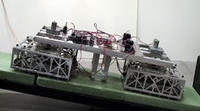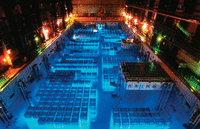-
National Academies calls for expanded nuclear-fusion research
A report out on Wednesday from the National Academies says university researchers studying nuclear fusion still have a long way to go before overcoming the many scientific hurdles to the commercial generation of what is hoped to be a virtually limitless supply of energy
-
-
Solving the major problem of renewable energy: intermittency
Intermittency, sometimes called the Achilles’ heel of renewable energy, has so far limited the penetration of renewable sources in most power grids; engineers imagine an energy future where giant transmission grids are backed up by massive energy storage units
-
-
Company develops telephone line “fingerprint” detector
Researchers at Pindrop, a new security company, have developed technology that can read telephone line “fingerprints” to prevent fraud and identify a caller
-
-
Pasta-shaped radio waves beamed across Venice
One solution to communication congestion during emergencies is to create a public safety-dedicated band of the spectrum, allowing for a unified and uninterrupted communication among first responders; another solution is twisting radio waves into the shape of fusilli pasta, allowing a potentially infinite number of channels to be broadcast and received
-
-
Poultry feathers-based filters remove arsenic from water
Thousands of people die each year in developing countries from drinking arsenic-contaminated water; researchers develop inexpensive filters made from the modified protein (keratin) in poultry feathers to remove arsenic from drinking water
-
-
Energy from differences between salt- and fresh water – produced inland
Production of energy from the difference between salt water and fresh water is most convenient near the oceans, but now, using an ammonium bicarbonate salt solution, researchers can combine bacterial degradation of waste water with energy extracted from the salt-water fresh-water gradient to produce power anywhere
-
-
Snake-emulating search-and-rescue robot

An all-terrain robot for search-and-rescue missions must be flexible enough to move over uneven surfaces, yet not so big that it is restricted from tight spaces; it might also be required to climb slopes of varying inclines; researchers say the solution would be a search-and-rescue robot which emulates the locomotion of a certain type of flexible, efficient animals: snakes
-
-
Researchers develop record-breaking plastic solar cell
Researchers at the University of California, Los Angeles (UCLA) have made a breakthrough with plastic solar cells, creating a record-breaking polymer cell that converts 10.6 percent of the sun’s energy into electricity
-
-
Physicists predict when brittle materials fail
It does not happen often, but structures like bridges, airplanes, and buildings do fail, sometimes catastrophically; what are the odds, and how can it be prevented? Researchers just published new theoretical insights into the probability of structural failures, based on hundreds of thousands of computer simulations
-
-
Detecting explosives from a distance with laser beams
Scientists have found a way to detect chemicals over long distances, even if they are enclosed in containers; the scientists tested the system by trying to detect frequently used explosives, such as TNT, ANFO, or RDX from a distance – and the tests were successful
-
-
Anthrax-decontamination foam used in meth lab cleanup
The meth cleanup problem in the United States is a big one; the U.S. Drug Enforcement Administration lists thousands of locations where law enforcement agencies have found chemicals or paraphernalia indicating the presence of either clandestine drug laboratories or dumpsites; Sandia’s decontamination foam, originally developed to deal with anthrax, is now also a meth eraser
-
-
Future aircraft could capture, re-use some of their own power
When an Airbus 320 lands, a combination of its weight and speed gives it around three megawatts peak available power; researchers work on making the aircraft of tomorrow contribute to their power needs by harnessing energy from the wheel rotation of their landing gear to generate electricity
-
-
Wireless bicycle brake to be shown in Cebit 2012

Scientists have developed a wireless bicycle brake; to brake with the wireless brake, a cyclist needs only clench the rubber grip on the right handle; the scientists say the brake has such a high reliability, only three out of one billion braking attempts will fail; “That is not perfect, but acceptable,” says one of the researchers
-
-
Cell phone-based sensor detects E. coli
Researchers have developed a new cell phone-based fluorescent imaging and sensing platform that can detect the presence of the bacterium Escherichia coli in food and water
-
-
Nuclear waste recycling for better nuclear power generation

Researchers aim to produce safe nuclear fuel that can be 80 percent recycled, compared to the current 1 percent; these fourth generation nuclear power systems can lead to a reduction of the amount of high-level, long-lived nuclear waste to a tenth of what it is today, while energy output can increase hundredfold
-
More headlines
The long view
New Technology is Keeping the Skies Safe
DHS S&T Baggage, Cargo, and People Screening (BCP) Program develops state-of-the-art screening solutions to help secure airspace, communities, and borders
Factories First: Winning the Drone War Before It Starts
Wars are won by factories before they are won on the battlefield,Martin C. Feldmann writes, noting that the United States lacks the manufacturing depth for the coming drone age. Rectifying this situation “will take far more than procurement tweaks,” Feldmann writes. “It demands a national-level, wartime-scale industrial mobilization.”
How Artificial General Intelligence Could Affect the Rise and Fall of Nations
By Barry Pavel et al.
Visions for potential AGI futures: A new report from RAND aims to stimulate thinking among policymakers about possible impacts of the development of artificial general intelligence (AGI) on geopolitics and the world order.
Keeping the Lights on with Nuclear Waste: Radiochemistry Transforms Nuclear Waste into Strategic Materials
By John Domol
How UNLV radiochemistry is pioneering the future of energy in the Southwest by salvaging strategic materials from nuclear dumps –and making it safe.
Model Predicts Long-Term Effects of Nuclear Waste on Underground Disposal Systems
By Zach Winn
The simulations matched results from an underground lab experiment in Switzerland, suggesting modeling could be used to validate the safety of nuclear disposal sites.
